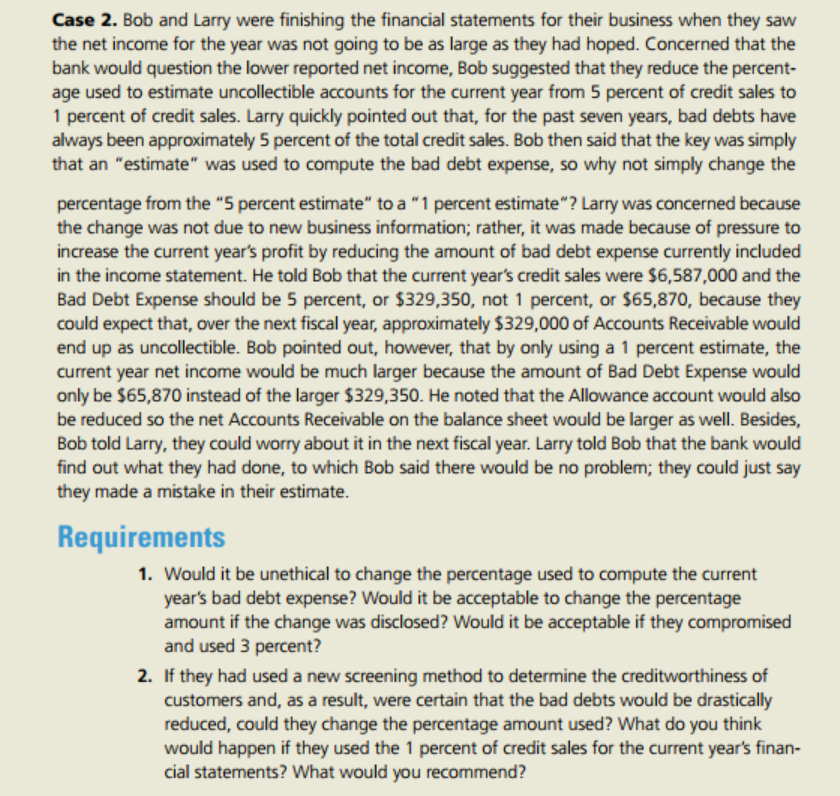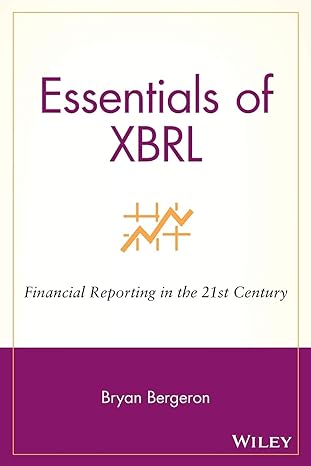
Case 2. Bob and Larry were finishing the financial statements for their business when they saw the net income for the year was not going to be as large as they had hoped. Concerned that the bank would question the lower reported net income, Bob suggested that they reduce the percent- age used to estimate uncollectible accounts for the current year from 5 percent of credit sales to 1 percent of credit sales. Larry quickly pointed out that, for the past seven years, bad debts have always been approximately 5 percent of the total credit sales. Bob then said that the key was simply that an "estimate" was used to compute the bad debt expense, so why not simply change the percentage from the "5 percent estimate" to a "1 percent estimate"? Larry was concerned because the change was not due to new business information; rather, it was made because of pressure to increase the current year's profit by reducing the amount of bad debt expense currently included in the income statement. He told Bob that the current year's credit sales were $6,587,000 and the Bad Debt Expense should be 5 percent, or $329,350, not 1 percent, or $65,870, because they could expect that, over the next fiscal year, approximately $329,000 of Accounts Receivable would end up as uncollectible. Bob pointed out, however, that by only using a 1 percent estimate, the current year net income would be much larger because the amount of Bad Debt Expense would only be $65,870 instead of the larger $329,350. He noted that the Allowance account would also be reduced so the net Accounts Receivable on the balance sheet would be larger as well. Besides Bob told Larry, they could worry about it in the next fiscal year. Larry told Bob that the bank would find out what they had done, to which Bob said there would be no problem; they could just say they made a mistake in their estimate Requirements 1. Would it be unethical to change the percentage used to compute the current year's bad debt expense? Would it be acceptable to change the percentage amount if the change was disclosed? Would it be acceptable if they compromised and used 3 percent? 2. If they had used a new screening method to determine the creditworthiness of customers and, as a result, were certain that the bad debts would be drastically reduced, could they change the percentage amount used? What do you think would happen if they used the 1 percent of credit sales for the current year's finan- cial statements? What would you recommend? Case 2. Bob and Larry were finishing the financial statements for their business when they saw the net income for the year was not going to be as large as they had hoped. Concerned that the bank would question the lower reported net income, Bob suggested that they reduce the percent- age used to estimate uncollectible accounts for the current year from 5 percent of credit sales to 1 percent of credit sales. Larry quickly pointed out that, for the past seven years, bad debts have always been approximately 5 percent of the total credit sales. Bob then said that the key was simply that an "estimate" was used to compute the bad debt expense, so why not simply change the percentage from the "5 percent estimate" to a "1 percent estimate"? Larry was concerned because the change was not due to new business information; rather, it was made because of pressure to increase the current year's profit by reducing the amount of bad debt expense currently included in the income statement. He told Bob that the current year's credit sales were $6,587,000 and the Bad Debt Expense should be 5 percent, or $329,350, not 1 percent, or $65,870, because they could expect that, over the next fiscal year, approximately $329,000 of Accounts Receivable would end up as uncollectible. Bob pointed out, however, that by only using a 1 percent estimate, the current year net income would be much larger because the amount of Bad Debt Expense would only be $65,870 instead of the larger $329,350. He noted that the Allowance account would also be reduced so the net Accounts Receivable on the balance sheet would be larger as well. Besides Bob told Larry, they could worry about it in the next fiscal year. Larry told Bob that the bank would find out what they had done, to which Bob said there would be no problem; they could just say they made a mistake in their estimate Requirements 1. Would it be unethical to change the percentage used to compute the current year's bad debt expense? Would it be acceptable to change the percentage amount if the change was disclosed? Would it be acceptable if they compromised and used 3 percent? 2. If they had used a new screening method to determine the creditworthiness of customers and, as a result, were certain that the bad debts would be drastically reduced, could they change the percentage amount used? What do you think would happen if they used the 1 percent of credit sales for the current year's finan- cial statements? What would you recommend







